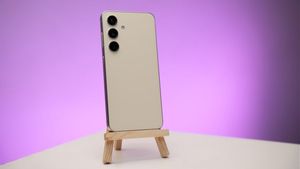JAKARTA - The night market was once the backbone of entertainment in Batavia in the 1900s. His presence is always awaited. It is also easy to find throughout Batavia. From Princen Park, Deca Park, to Gambir Market. A variety of entertainment is the mainstay. Boxing, for example. Every day the boxing was held, the interest of the people of Batavia rose. Especially when the boxen match (boxing fight) brought together the natives and the Dutch. The match made boxing fights on the rise. Therefore, boxing gyms thrived in Batavia.
The night market in Batavia is often lively. The celebrations were held in strategic locations. All to reach the people throughout Batavia. The Dutch and the natives. Visitors did not want to lose. Every night market they don't forget to prepare their best clothes.
The night market he visited was varied. Starting from the night market held at Princen Park (Loakasari), Deca Park (Lampangan Monas), Varia Park (Krekot), and Gambir Market. The visitors who come come down to one goal: to unwind. Because, at the location of the night market, every visitor will be spoiled with a variety of entertainment. There is entertainment for children, there is also entertainment for adults.

The Dutch colonial government did not forget to take part in organizing the night market. They are happy to give permission to use the city parks as prime locations. Later, a large stage for theatrical or musical performances was built. Other entertainment that is on the rise is the presence of an open-air cinema or idoep pictures – in the words of the Betawi people. Not to mention the European-style dance events.
The joy of coming to the night market is second to none. Moreover, you can come to the special night market. Gambir Market, the name. The special nuance is because the event is held only a few days a year. The celebration of the night market was specially presented by the Dutch to commemorate the coronation of Queen Wilhelmina on August 31, 1898. Also the implementation starts from August 31 until mid-September every year.
“In this enormous crowd of people (at Pasar Gambir), there is nothing but light, color and peace; peace especially, taken by color and light, each time when the scene is brightened by sudden bursts of light from a large film theater, as the projector releases a wide beam of light over the entire field; now everyone is shining, now dark red, now dark blue, now fierce orange."
“For us, that's the joy of the show! The faces of the peaceful happiness of thousands; image, which repeatedly emerged from the darkness in the intense beam of the film projector. Always stunning colorful still photos, and the flickering orange and red lights of the stalls, “said author CM Vissering as quoted by Rudolf Mrázek in the book Engineers of Happy Land: Technological Development and Nationalism in a Colony ( 2006).
Boxing Fighting PopularityIt could be entertainment at the bejibun night market. However, when it comes to attracting a large crowd, boxing fights are a mainstay. Even though boxing was a sport that had just entered the Dutch East Indies, and even then, it was brought by Dutch soldiers, the business of providing entertainment that entertained boxing could be contested.
Every boxing held at the Princen Park night market, Deca Park, and Gambir Market, the people of Batavia were immediately enthusiastic. They immediately flocked to the night market. Cheap entertainment, he thought. Visitors just buy an entrance ticket. The excitement of a boxing match can be enjoyed immediately. Alias, no need to buy tickets to watch boxing.
“You could say that the cultural roots of the Jakarta Fair (PRJ) now come from the old night market or the legacy of Princen Park. However, PRJ and previously Gambir Market were held once a year. As a place of entertainment, Princen Park every night presents a variety of performances. Starting from open cinema or idoep pictures according to Betawi people."
“Also often held keroncong competitions, featuring famous singers at that time. There is also a special hall for boxing matches. During boxing matches, the night market visitors are more. Moreover, there is no charge, just show the entrance ticket. Kerak telor, a Betawi specialty, of course, is a souvenir for visitors at home,” said Alwi Shahab, an important figure in the history of Jakarta, in his book Betawi: Queen of the East (2002).

The popularity of boxing makes many people avid boxing, including the natives. Archaeologist and observer of history, Djulianto Susantio agrees with this. Enthusiasm to practice boxing increased when the name of the bumiputra boxer, Kid Darlin emerged as one of the popular boxers of that era. That said, Kid Darlin is predicted to be the first Bumiputra boxer to appear in the ring. Kid Darlin's reputation then inspired other natives to love boxing.
Hoegeng Imam Santoso, one of them. Long before becoming the National Police Chief, Hoegeng had tasted college, even though he didn't graduate, at the Law College, Recht Hoge School (RHS) in Batavia in 1940. During his studies, boxing or boxing became the honest policeman's favorite hobby. Whenever there is an opportunity, Hoegeng always practices boxing and looks for a duel partner. Hoegeng is proof that boxing has been widely accepted by the natives.
“Besides that, I also fill my spare time by learning ballroom dance on Jalan Kebon Sirih, and also learning to play boxen (boxing). However, as soon as I started practicing boxen with Tom Koguchi, I was immediately knocked out on the canvas,” concluded Hoegeng as written by Abrar Yusra and Ramadhan KH in the book Hoegeng: Police Idaman and Reality (1993).
The English, Chinese, Japanese, Arabic, and French versions are automatically generated by the AI. So there may still be inaccuracies in translating, please always see Indonesian as our main language. (system supported by DigitalSiber.id)













